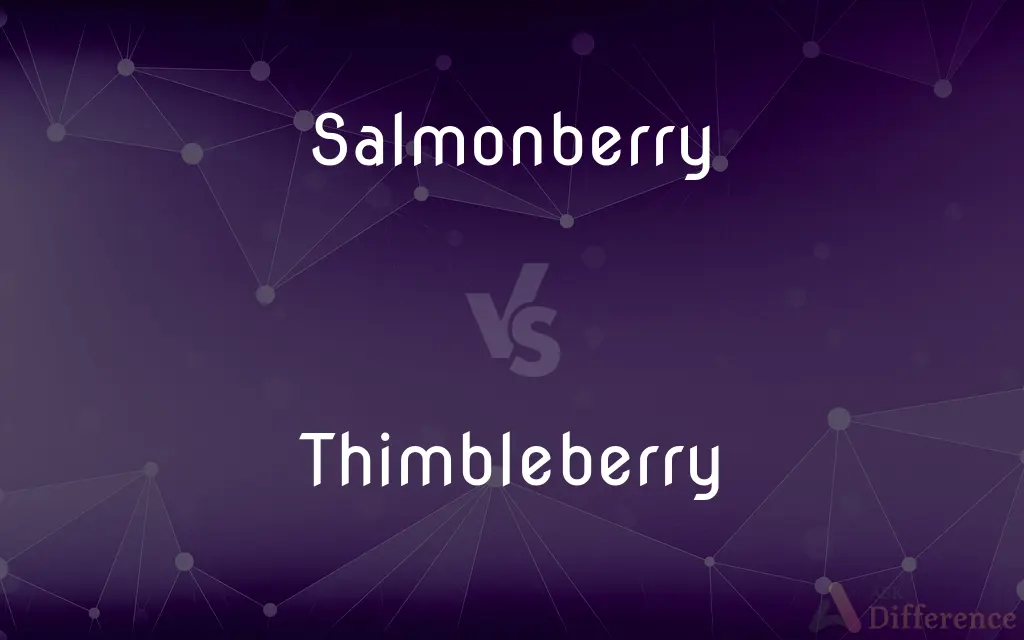Salmonberry vs. Thimbleberry — What's the Difference?
By Tayyaba Rehman & Fiza Rafique — Updated on April 19, 2024
Salmonberries are orange or red berries with a mild, slightly sweet flavor, related to raspberries; thimbleberries are red, softer, and have a tart, distinctive taste, without the woodiness in their stems.

Difference Between Salmonberry and Thimbleberry
Table of Contents
ADVERTISEMENT
Key Differences
Salmonberries (Rubus spectabilis) and thimbleberries (Rubus parviflorus) are both members of the Rubus genus, which also includes raspberries and blackberries. Salmonberries are often found in moist forests and stream margins across the Pacific Northwest. They produce berries that range in color from yellow to deep orange or red and have a mild, somewhat bland taste compared to other berries. In contrast, thimbleberries are known for their large, soft, velvety fruits that are bright red and have a more pronounced tart flavor, making them a favorite for jams and jellies.
The bushes of salmonberries feature prickly stems and grow taller, up to 6 feet, often with sprawling branches. They also have toothed, green leaves and pink flowers. Thimbleberries, however, have a different physical appearance, with smooth, cane-like stems without thorns and broad, maple-like leaves. Their flowers are white and larger than those of salmonberries.
In terms of habitat, while both plants prefer shaded, moist environments, salmonberries are more tolerant of wet conditions and can often be found near rivers and in damp woodlands. Thimbleberries prefer slightly drier, more open areas but still thrive in similar forested environments.
Culinary uses of these berries also differ. Salmonberries are often eaten fresh or made into wine and are sometimes considered too watery or bland for preserves without the addition of more flavorful fruits. Thimbleberries, with their robust flavor, are excellent in preserves, pies, and desserts, and are rarely eaten raw due to their soft texture.
Both berries hold significance for indigenous peoples in the Pacific Northwest, used historically as a food source and in traditional medicines. However, thimbleberries are often noted specifically for their medicinal properties, including use in treating digestive issues.
ADVERTISEMENT
Comparison Chart
Olor
Yellow to deep orange or red
Bright red
Taste
Mild, slightly sweet
Tart, flavorful
Plant Height
Up to 6 feet
Up to 5 feet, but shorter
Stem Characteristics
Prickly
Smooth, no thorns
Leaf Shape
Toothed, green leaves
Broad, maple-like leaves
Preferred Habitat
Moist forests, stream margins
Forest edges, slightly drier areas
Culinary Uses
Fresh eating, wine
Preserves, pies, desserts
Compare with Definitions
Salmonberry
Has mild sweetness, often mixed with other fruits in culinary uses.
The salmonberry jam needed extra raspberries for flavor.
Thimbleberry
Used medicinally by native cultures.
Thimbleberry leaves were used traditionally to soothe stomach pains.
Salmonberry
Eaten fresh or used in traditional beverages.
They made a light wine from the salmonberries they gathered.
Thimbleberry
Commonly found in open but shaded areas.
Thimbleberries flourished under the canopy's edge where the sunlight filtered through.
Salmonberry
Grows on a bush with prickly stems.
Be careful of the thorns when picking salmonberries.
Thimbleberry
Known for its large, velvety, red berries.
The thimbleberries were especially lush this year, dotting the hillside in bright red.
Salmonberry
A berry that grows predominantly in the Pacific Northwest, known for its varying color.
Salmonberries were ripe and ready for picking along the trail.
Thimbleberry
Lacks thorns, making it easier to handle.
Picking thimbleberries was a joy compared to the prickly blackberry bushes.
Salmonberry
Found in wet environments near water.
Salmonberry bushes thrived by the riverside.
Thimbleberry
A soft, tart berry ideal for jams and desserts.
Thimbleberry jam is a special treat due to its rich flavor.
Salmonberry
A prickly shrub (Rubus spectabilis) of western North America, having trifoliolate leaves and fragrant pinkish or purple flowers.
Thimbleberry
Any of several raspberries, especially Rubus parviflorus of western North America, having edible, thimble-shaped, usually red aggregate fruit.
Salmonberry
The edible salmon-colored raspberrylike fruit of this plant.
Thimbleberry
The fruit of any of these plants.
Salmonberry
A bush, Rubus spectabilis, found on the Pacific coast of North America.
Thimbleberry
Rubus parviflorus, a species of Rubus, native to western and northern North America, from Alaska east to Ontario and Minnesota, and south to northern Mexico.
Salmonberry
The fruit from this bush, similar in appearance and texture to the blackberry and raspberry.
Thimbleberry
The fruit of the above plant.
Salmonberry
Creeping raspberry of north temperate regions with yellow or orange berries
Thimbleberry
The black raspberry, Rubus occidentalis.
Salmonberry
White-flowered raspberry of western North America and northern Mexico with thimble-shaped orange berries
Thimbleberry
A kind of black raspberry (Rubus occidentalis), common in America.
Salmonberry
Large erect red-flowered raspberry of western North America having large salmon-colored berries
Thimbleberry
Shrubby raspberry of eastern North America having showy rose to purplish flowers and red or orange thimble-shaped fruit
Thimbleberry
White-flowered raspberry of western North America and northern Mexico with thimble-shaped orange berries
Thimbleberry
Raspberry native to eastern North America having black thimble-shaped fruit
Common Curiosities
What wildlife relies on salmonberries?
Salmonberries are an important food source for birds, bears, and other wildlife in the Pacific Northwest.
How can you identify a salmonberry bush?
Look for its characteristic pink flowers, prickly stems, and the presence of either orange or red berries depending on maturity.
Are thimbleberries easy to cultivate?
Thimbleberries are relatively easy to grow in suitable climates, especially in areas with good drainage and partial shade.
What is the best way to preserve thimbleberries?
Due to their soft texture, thimbleberries are best preserved by making them into jams, jellies, or syrups.
What is the peak season for harvesting salmonberries?
Salmonberries are typically ready for harvest in late spring to early summer, depending on the local climate.
What are common uses for thimbleberry leaves?
Thimbleberry leaves have been used traditionally for their medicinal properties, including topical applications for skin irritations.
How do salmonberries and thimbleberries differ in their growth environment?
Salmonberries prefer more consistently moist environments like stream margins, while thimbleberries can tolerate slightly drier, more exposed areas.
How should salmonberries be stored after picking?
They should be refrigerated and eaten or processed soon after picking due to their relatively high water content and mild flavor.
Can you mix salmonberries and thimbleberries in recipes?
Yes, combining them can balance the mildness of salmonberries with the tartness of thimbleberries, enhancing the overall flavor.
Which berry is more nutritious?
Both berries are nutritious, offering vitamins and antioxidants, but thimbleberries have a slightly higher content of dietary fiber and vitamin C.
Are thimbleberries higher in acidity than salmonberries?
Yes, thimbleberries have a higher acidity, which contributes to their tartness and makes them excellent for jams and preserves.
Do salmonberries require a lot of water?
They thrive in moist conditions, so ample watering is necessary if not grown near a natural water source.
Can you eat thimbleberries raw?
While they can be eaten raw, their soft texture and strong flavor often make them better suited for cooked dishes or preserves.
Can thimbleberries be used in baking?
Yes, their robust flavor and moisture content make them excellent for baking in pies and other desserts.
What are the challenges of growing salmonberries commercially?
Their preference for specific climatic conditions and the difficulty in transporting them due to their soft texture pose challenges for large-scale commercial farming.
Share Your Discovery

Previous Comparison
Apparent vs. Clear
Next Comparison
Sociability vs. SocialityAuthor Spotlight
Written by
Tayyaba RehmanTayyaba Rehman is a distinguished writer, currently serving as a primary contributor to askdifference.com. As a researcher in semantics and etymology, Tayyaba's passion for the complexity of languages and their distinctions has found a perfect home on the platform. Tayyaba delves into the intricacies of language, distinguishing between commonly confused words and phrases, thereby providing clarity for readers worldwide.
Co-written by
Fiza RafiqueFiza Rafique is a skilled content writer at AskDifference.com, where she meticulously refines and enhances written pieces. Drawing from her vast editorial expertise, Fiza ensures clarity, accuracy, and precision in every article. Passionate about language, she continually seeks to elevate the quality of content for readers worldwide.














































